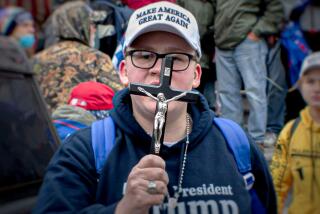Contradictions Marked Nixon’s Religious Life : Presidency: He had both defenders and critics among the clergy. His Quaker upbringing shaped his personality, biographers say, but not necessarily his actions.
Richard Nixon viewed the American religious community in much the same way he did other groups and institutions: some as friends, some as foes.
His friends included evangelist Billy Graham, who professed disappointment in Nixon after Watergate but who persistently called the 37th President, who died last week at age 81, a friend he could never forsake and for whom he often prayed.
Graham, in fact, was the first speaker at the White House worship services Nixon initiated on the Sunday after his first inauguration in 1969. Twenty-six such services were held during the first two years of his presidency.
Nixon, a Quaker, said he wanted the services to remind the Administration that “we feel God’s presence here, and that we seek his guidance here.”
The late Norman Vincent Peale was also a frequent preacher at the worship services and performed the marriage of Julie Nixon and David Eisenhower in December, 1968.
Nixon’s most outspoken defenders toward the end of his scandal-ridden presidency were Rabbi Baruch Korff and the Rev. John McLaughlin, the Jesuit priest and presidential aide who has since become a television host and commentator.
The religious community also was the source of some of Nixon’s most persistent critics, however.
Quakers in Milwaukee and Minneapolis, citing Nixon’s abuse of power, called for his impeachment a full six months before he finally resigned in August, 1974. The National Council of Churches, the nation’s largest ecumenical organization, also called for his impeachment.
Even before he introduced articles of impeachment against Nixon, the Rev. Robert Drinan, the former Massachusetts congressman and member of the House Judiciary Committee, made the infamous White House “enemies list” for his outspoken opposition to the Vietnam War.
Two other clergymen also made the list: the Rev. Eugene Carson Blake, who was general secretary of the World Council of Churches, and the Rev. Ralph Abernathy, president of the Southern Christian Leadership Conference.
*
And though he did not make the list, the American ethicist and theologian Reinhold Niebuhr raised the ire of the White House when, in one of his last major articles, he warned against the White House worship services as an inappropriate mixing of religion and secular power.
“President Nixon has turned the East Room into a kind of sanctuary and, by a curious combination of innocence and guile, has circumvented the Bill of Rights’ first article,” Niebuhr wrote.
The man at the receiving end of Niebuhr’s criticism was only the second Quaker to serve as a U.S. president. Herbert Hoover was the first.
Nixon’s father, Frank, came from a conservative Methodist background, but after marrying Hannah Milhous, joined a Quaker congregation. According to Richard V. Pierard and Robert D. Linder, in their book “Civil Religion and the Presidency,” she saw to it that the Nixon children “received a common religious upbringing in the Friends Sunday school.”
Nixon attended Quaker-affiliated Whittier College and, when World War II began, volunteered to work for the Office of Price Administration. Although as a Quaker he received a religious exemption from military service, he waived it and took a commission in the Navy.
According to Pierard and Linder, “religious observance was a central feature of his youth” and had “a profound impact” on the shaping of his personality. They argue that Nixon’s Quaker experience resulted in “a blending of private reserve and public confidence.”
Nixon included in his 1978 book “RN: The Memoirs of Richard Nixon” a 1930 paper written for a class at Whittier that he described as still reflecting his beliefs.
The former President noted that he had given up some of his childhood beliefs in such things as the inerrancy and infallibility of the Bible but still believed God was the Creator and that Jesus was the son of God--but not in the physical sense of the term.
*
But he also maintained in the paper that, in effect, “Jesus and God are one, because Jesus set the great example which is forever pulling men upward to the ideal life. His life was so perfect that he ‘mingled’ his soul with God’s.”
Others expressed confusion about Nixon’s statements of faith. Carl F.H. Henry, then editor of the evangelical magazine Christianity Today, interviewed Nixon during the 1968 presidential campaign and found him “remarkably imprecise about spiritual realities and enduring ethical concerns.”
Evangelicals would later express disappointment and shock at the Nixon portrayed in the White House tapes: a profane and vindictive man.
The Rev. Pat Robertson, for example, demanded that Nixon apologize to America’s Christians who, he said in 1974, were “the victims of a cruel hoax.”
He said the private Nixon was totally at variance with his public image as a man of probity and piety.
As one example, Robertson said: “We can surmise that Dr. Billy Graham has been used for political image-building.”
However, such a contradiction did not surprise the Rev. Wallace Henley, a Southern Baptist preacher and onetime White House aide who wrote a book in the wake of the Watergate scandal entitled, “The White House Mystique.”
He said fellow evangelicals would not have been so shocked had they not “been so eager to adopt Nixon as one of our own.”
“God could be worshiped in the East Room on Sunday, and lies be told in the press room on Monday,” Henley wrote. “Pragmatism permitted no questions about contradictions. It dictated that whatever had to be done to maintain power--be it in the worship of God or the twisting of information--it should be done.”
More to Read
Sign up for Essential California
The most important California stories and recommendations in your inbox every morning.
You may occasionally receive promotional content from the Los Angeles Times.










